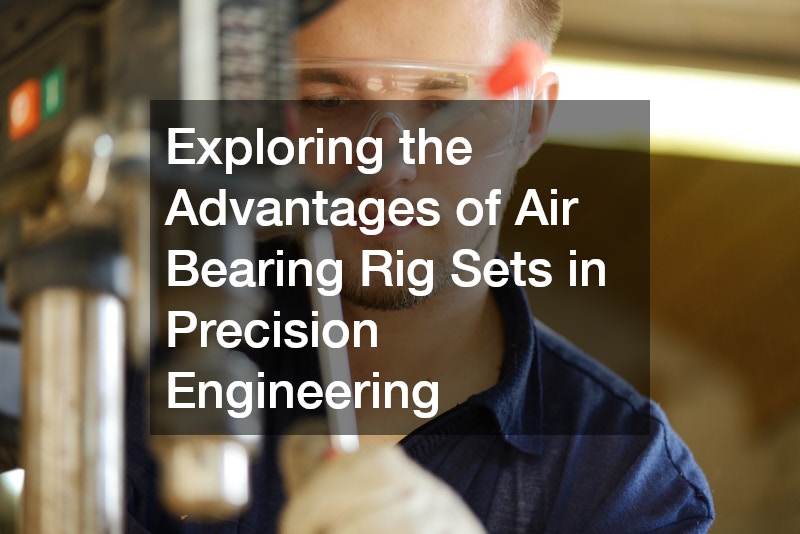
This article delves into the transformative role of air bearing rig sets in precision engineering, unveiling their advantages in enhancing accuracy, efficiency, and innovation in engineering processes. As precision engineering evolves, air bearings have emerged as a pivotal technology driving this change. Understanding the scope and effectiveness of these systems is crucial for industry professionals seeking to optimize their engineering outcomes.
How Do Air Bearing Rig Sets Enhance Precision in Engineering?
Air bearing technology operates on the principle of providing a frictionless environment by using a thin layer of air between surfaces. This technique allows for non-contact movement, which is vital for precision in various engineering applications. Engineers rely on these bearings to achieve micro-level precision in aerospace, semiconductor, and other high-tech industries.
The air bearing system’s fundamental principle is to eliminate the direct contact that causes mechanical perturbations. By suspending the moving parts on a cushion of air, air bearings effectively reduce any potential inaccuracies. This outcome is particularly significant when dealing with components that require impeccable synchronization and alignment.
Utilizing air bearings in engineering results in enhanced repeatability and accuracy. The lack of physical contact minimizes thermal expansion and material deformation, often caused by frictional forces. These characteristics are essential for industries striving for high precision in both the design and implementation phases.
Air bearing rig sets have significantly improved measurement accuracy in precision engineering processes. This enhancement is largely due to their ability to eliminate nearly all frictional losses and produce stable and repeatable motion. In high-precision tasks, the reliability of measurements is greatly increased, leading to more consistent manufacturing outputs.
In environments where measurement fidelity is paramount, air bearings excel by providing consistency and eliminating mechanical noise. For example, in optical measurement systems, the absence of friction-induced vibration enables clearer and more reliable readings. Such precision ultimately leads to more successful project outcomes and greater customer satisfaction.
What Are the Key Advantages of Using Air Bearing Rig Sets?
Air bearing rigs are known for their enhanced load capacity, which allows them to manage higher loads effortlessly. This aspect is critical for applications requiring significant carrying capabilities without compromising on precision. High-load tasks that utilize air bearings enjoy increased stability and operational smoothness.
The ability to handle larger loads also extends the usability of air bearings across various industrial sectors. By accommodating diverse weight specifications, air bearings provide solutions where traditional bearings might fail. This adaptability makes them an ideal choice for innovative engineering applications.
The superior load management is achieved through an even distribution of air pressure across the bearing surface. This enhances the support system and prevents localized stress concentrations that could damage components. Hence, industries relying on complex machinery greatly benefit from the robust load capacities offered by air bearing technology.
Superior stability and control are trademarks of air bearing rig systems, making them highly favored in precision engineering. The non-contact nature grants unparalleled control over movement and alignment. This feature is particularly important when precise positioning and minimal vibration are prerequisites for success.
Stable operations are essential in fields like aerospace and robotics, where precise navigation and control are paramount. For instance, in robotics, air bearings enable smooth motion trajectories, facilitating intricate task execution with high repeatability. Such stability is instrumental in avoiding disruptions and ensuring the smooth operation of engineering systems.
The control offered by air bearings allows for highly dynamic operations without the concern of mechanical wear. Systems gain the advantage of maintaining precise control over their entire operating range, thereby achieving optimal performance with minimal errors. Engineers can rely on this precision and stability for developing advanced technological solutions.
How Do Air Bearing Rig Sets Compare to Traditional Bearing Systems?
When comparing air bearings to traditional bearings, the efficiency and performance edge is visible. Air bearings offer reduced friction and enhanced smoothness, significantly outperforming their conventional counterparts. Their proficiency in reducing energy consumption while maintaining high-performance metrics underscores their benefits in precision engineering.
This performance advantage is crucial for industries where energy savings and operational efficiency constitute significant concerns. For example, in electronics manufacturing, air bearings reduce production costs by enabling rapid and precise operations. This efficiency ultimately translates into improved turnaround times and enhanced competitive advantage.
The frictionless operation ensures minimal energy loss, reflecting a more sustainable engineering practice. In environments that prioritize eco-friendly solutions, air bearing technology becomes an appealing choice due to its energy-saving capabilities. Therefore, the integration of air bearings aligns with modern engineering goals and sustainability initiatives.
The overarching benefits of adopting air bearing rig sets in precision engineering highlight their capacity to revolutionize industry standards through enhanced precision, performance, and longevity. By minimizing friction and providing unmatched accuracy, air bearings ensure superior engineering outcomes. Their versatility across industries and commitment to sustainability make them a key technology for advancing engineering capabilities.

